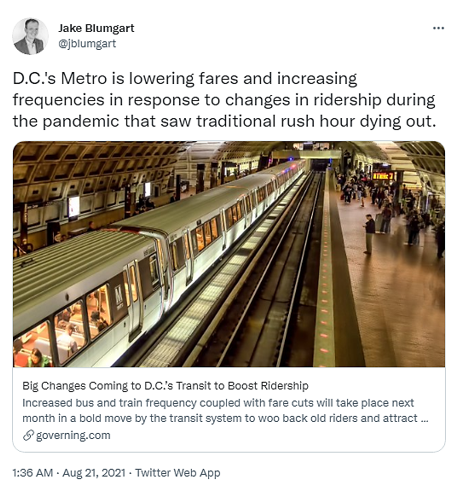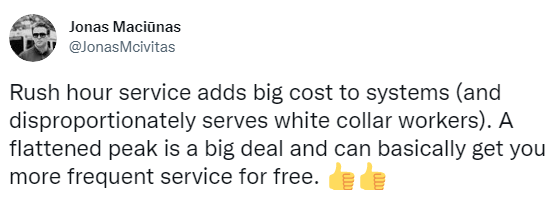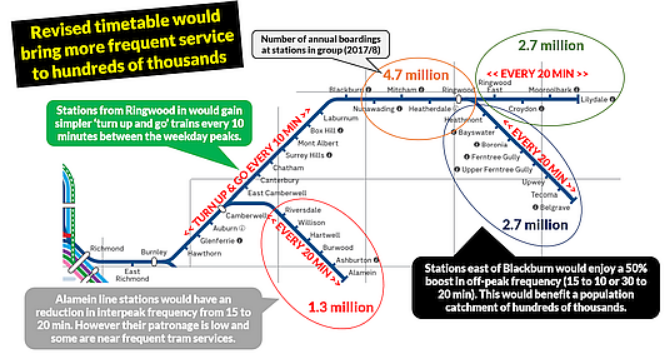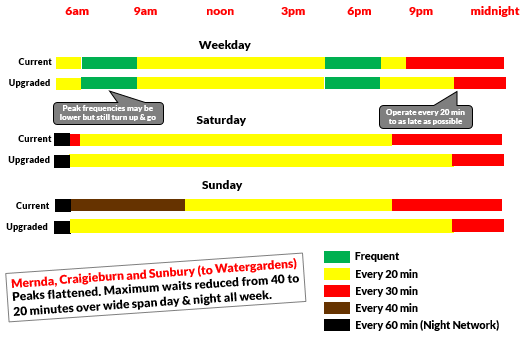DC transit honchos have recognised this doesn't make sense. So they're shifting service around. Peaks will be flattened, with savings reinvested in better off-peak frequency. Not only for Metro trains but also 36 key bus lines. Fare system bus-train transfer penalties (something Melbourne abolished years ago but the misguided Infrastructure Victoria wishes to bring back) will also be removed.
Modelling shows that off-peak patronage responds better to increased frequency than peak patronage. Farebox cost recovery is generally highest on systems with high off-peak frequency. So DC's shift to embrace off-peak passengers should be good for both its finances and social equity.
We in Melbourne should sit up and take notice. Here's five examples where Melbourne can follow DC's lead for close to zero extra ongoing cost. This is based on an unchanged number of trips per week but a small shift in when they run to favour off-peak periods. The examples selected will benefit the most people on our busiest lines and routes.
1. 10 minute or better all-day trains to Ringwood
This is the biggest and best. Currently the Belgrave and Lilydale lines have a very intensive peak service with many stopping patterns that just confuse people. Off-peak service, in contrast, is sparse, with half hour gaps between trains at the twelve stations east of Ringwood. Weekends actually get a better timetable on these lines, with 20 minute daytime intervals except for Sunday mornings.
Reform here would simplify peak services with fewer unique stopping patterns. There could be fewer trains per hour passing in the peaks but there would be more frequency on each stopping pattern that is retained. The savings would go to adopting a superior weekend day-style timetable during interpeak (and preferably evening) times. This should deliver consistent off-peak trains every 10 minutes to the 17 stations from Burnley to Ringwood and 20 minutes to the 12 stations beyond for no extra operating cost.
There are two main trade-offs but both are minor. Firstly, interpeak trains would stop all stations, unlike the expressing we currently see. However the better frequency would more than offset the extra in-train travel time (especially as waiting is perceived longer than time in motion). Also the Alamein line would drop from every 15 to every 20 minutes interpeak. However its usage is low with the loss far outweighed by the much larger gains elsewhere.
2. Cutting Sandringham line maximum waits from 40 to 20 min
This one is smaller but still good. After setup costs it should be operationally cost-neutral. Peak service would remain at turn-up-and-go levels after this change.
Currently the Sandringham line has 20 minute maximum waits at all times except for early Saturday morning (30 minutes) and much of Sunday morning (40 minutes). Adding just five extra trips each way per week (1 on Saturday, 4 on Sunday) would slash maximum waits to 20 minutes between 6am and midnight, 7 days per week. Those five trips would be funded by removing one or two weekday peak trips and re-arranging other trips to close gaps otherwise created.
Because these will still be at turn-up-and-go frequencies (every 8 - 9 minutes), no one would notice this change yet resources would be freed for a more consistent service with halved maximum waits. The message to passengers would be an 'all-day railway' suitable for more types of trips at more times.
3. Doncaster Rd off-peak buses every 10 minutes?
Buses in Melbourne are not known to be particularly frequent, but Route 906 from Warrandyte Bridge to the city is an exception. Especially in peaks. The route's origin is not particularly densely settled and it's likely that residents want to keep it that way. Yet it enjoys an amazing peak-of-peak frequency of 4 to 5 minutes. This is over its entire route, even though economies like operating only every second trip the whole way could reduce operating costs.
Other Doncaster area routes also have high peak frequencies. Where peak service is better than every 10 minutes and occupancy is low, there may be scope to redistribute resources to better off-peak service. The stand-out route for this treatment is likely the 907 along Doncaster Rd. It's a busy route that links many local trip generators. It also provides a freeway express service to the city. Potential 907 upgrades could include boosting interpeak service from 15 to 10 minutes, boosting weekend service from every 20 to every 15 minutes or, less radically, widening the span that the existing 20 minute weekend service operates so it starts earlier and keeps going later.
4. Mernda, Craigieburn and Watergardens 20 min max waits
Seven day/all day 10 minute service would be desirable here. You can't fund that by redirecting peak services alone. But you could remove a lot of the 30 - 40 minute waits that plague these lines.
The key point is how few extra timetabled trips per week are needed to make a big difference.
For example these lines all have 40 minute Sunday morning frequencies, that is 3 trains every 2 hours. Increasing this to every 30 minutes for a two hour period requires just one return trip per week to be added. For the more desirable 20 minute frequency a still low three extra return trips per week would be needed. As comparison, lines in Sydney and Perth have 15 minute Sunday morning frequencies so those proposed here are unexceptional and even niggardly.
Where else could a few extra trips make a big difference? Early evenings is most notable. Instead of starting as early as 7:30pm, the 30 minute service these lines get could be pushed back to late evening or even eliminated. Two extra return trips per day could deliver a 20 minute maximum wait until 9:30 or 10pm, greatly improving each line's usefulness, especially for service workers.
The above improvements are scale-able, depending on how much you wanted to flatten peak service. In no case would you want peak gaps more than 10 minutes. And you might even want to slightly boost peak frequencies at certain times like early mornings when blue collar workers, who can't work from home, travel. These are important lines serving areas serving a lot of low income workers with irregular hours. Getting to a 20 min minimum frequency is essential even if you needed to flatten the peaks of other lines where spare capacity may exist (eg Frankston).
5. Dandenong line weekend evening and Sunday morning boost
There is currently no relationship between how busy a rail line is and its frequency, particularly on weekend evenings. For example the short and quiet Williamstown line enjoys a 20 minute maximum wait on Sunday mornings and weekend evenings. In contrast, Melbourne's busiest line to Dandenong/ Pakenham/ Cranbourne has 30 minute waits on weekend evenings and Sunday mornings. This is even after timetable upgrades that boosted weeknight service to 10 minutes until late.
Ultimately there should be no time that trains run from the city to Dandenong at intervals of more than 10 minutes, except for Night Network during the wee hours. For now though, even an upgrade from 30 to 20 minutes, requiring maybe 10 to 12 extra return trips per week, would be significant. Again a redistribution of two to four trips from the weekday timetable to pay for it might be possible without noticeable impact.
Conclusion
Opportunities exist for basically zero cost service upgrades that flatten the peaks, respond to COVID's changed travel patterns and make our network more fit for modern and emerging travel needs. This should be possible while retaining a 'turn up and go' peak service. Hence their effect on peak passengers should be minimal while delivering reduced maximum waits at over 100 train stations and some bus stops. The result would be an 'all-day railway' that's easier to use with more consistent service. It would also extend to much of the network many benefits that upgrades to Frankston, Werribee and Williamstown train services did in January 2021.
Index to Timetable Tuesday items here







3 comments:
Review of 906 bus peak frequency could also consider 901 bus shortworkings to Blackburn to feed more pax to trains and improve access to key destinations including Box Hill, Camberwell, Swinburne, Burnley/Cremorne & Southbank
Note 906 (& other DART routes) were near capacity before pandemic/WFH despite 4-5 min peak service
More artics should be ordered for DoncasterBusway services
On trains, what are your thoughts of a 20 min all day service to Sunbury (versus current 40 mins) - where does this fit in priorities?
Excellent suggestions Peter and would be cheap to implement too. With currently Melbourne in lockdown and far less peak hour commuting occurring due to covid 19, now is a perfect time to slightly reduce peak hour service on some lines Lilydale/Belgrave and Dandenong lines come to mind which have extra capacity currently. The trade off of increased frequency at off peak times would benefit far more passengers and reflect the current environment of more flexible working hours, shift work and people working from home. I agree all train lines should have a 20 minute maximum wait at all times, maybe except for quite portions of lines such as Eltham to Hurstbridge and the Alamein line and excluding the night network.
I agree about the confusing stopping patterns on the "Ringwood" lines but one good feature of the current timetable is the express trains in both directions after the morning peak. If one has to go the city in the morning, train is an excellent option. But around midday when the loop direction changes the service is unattractive with "stoppers" on various patterns.
Perhaps Warrandyte is overserviced but DART was certainly a big improvement. Good suggestion about 906 short workings to Blackburn but the current timetable does offer this option albeit with a change between 906 and 901.
Post a Comment